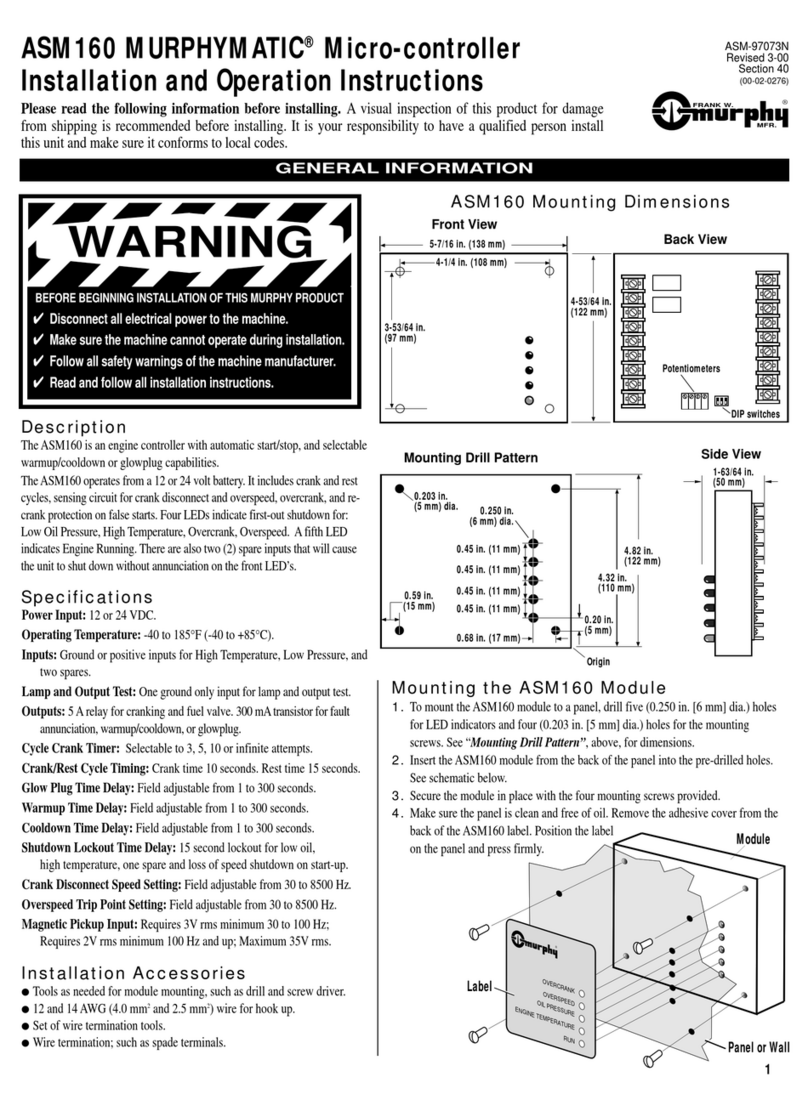12 turns. Be prepared to remove the wire from the ASM170 cranking
output as soon as the engine starts. Put the selector switch in the manual
position, and remove the cranking wire as soon as the engine starts.
Slowly turn R3 counter clockwise until the green run led turns on.
Manually start the engine. If the starter does not stay engaged long
enough, turn R3 one turn clockwise. Repeat this process if necessary. If
the starter stays engaged too long, turn R3 one revolution counter
clockwise. Repeat this process if necessary.
Multifunction Timer Delay (R4 Pot) – Selected by dip switches 3, 4,
and 5 (Ranges of adjustment explained below)
The Multifunction Timer Delay adjustment pot is used to adjust how
long this output is on. There are several options for this adjustment pot.
First select which function you want with the DIP switch, and then adjust
this delay to the desired setting. Turn clockwise to increase and
counterclockwise to decrease.
Lockout Delay (R5 Pot) – Adjustable between 1 and 300 seconds
The lockout delay is used to ignore indications for shutdown on the
pressure and temperature shutdown inputs. This delay begins timing as
soon as the crank disconnect occurs. To increase the setting, turn the Pot
clockwise; to decrease the setting, turn the Pot counterclockwise.
Overcrank Adjustments (DIP Switches)
The ASM170 allows you to crank the engine 3, 5, 10, or 255 times. If
after these attempts the engine fails to start, the unit will signal
OVERCRANK. If the engine false starts and the ASM170 RE-CRANK’s
the engine, it will count this as a cranking attempt. This way, if the
engine false starts the same number of times as your cranking attempts,
then the unit will show OVERCRANK.
Multifunction OUTPUT Options
There is one output on the ASM170 that can be configured to operate in
a variety of ways. Below, you will find a description of each of these
functions. To select the function, find it on the previous chart and flip the
appropriate DIP switches to match.
GLOWPLUG: When this option is selected, the multifunction output is
used to heat the glow plugs of a Diesel engine prior to attempting to
start. Once selected, you can adjust the glowplug time delay by turning
pot R4. The delay can be set from 1 to 300 seconds. When a start signal
is received, the output will turn on for the amount of time set on R4. It
will then turn off while the crank cycle time delay is active. If the engine
fails to start, the output will turn on again after the rest delay but prior to
the crank function.
COOLDOWN: When this option is selected, the multifunction output
will turn on after a stop signal is received and stay on during the delay. It
is adjustable between 1 and 300 seconds. When the delay expires, the
output will turn off, along with the fuel valve, which will cause the
engine to stop.
WARMUP/COOLDOWN: When this option is selected, the warmup
delay begins timing as soon as the engine is sensed to have started.
When the delay expires, the multifunction output turns on and stays on
until a stop signal is received the output turns off immediately and the
delay begins timing again. When it expires, the fuel valve output is
turned off causing the engine to stop. This delay is adjustable between 1
and 300 seconds.
WARMUP: When this option is selected, the output will turn on as soon
as the engine is sensed to have started and stay on throughout the delay.
When the delay expires, the output will turn off. This delay is adjustable
between 1 and 300 seconds.
AIRGATE – OVERSPEED: When this option is selected, the output
will turn on only if an OVERSPEED shutdown condition is sensed. It
will stay on for an adjustable period of 1 to 30 seconds.
AIRGATE – ALWAYS: When this option is selected, the output will
turn on during any shutdown condition. It will stay on for an adjustable
period of 1 to 30 seconds. This output can also be used for energized to
stop applications.
CHOKE: When this option is selected, the output will turn on 3 seconds
into even number crank attempts. It will also immediately turn on if the
engine stalls. If the engine is sensed to be running, it will turn off.
AUXILIARY RUN OUTPUT: When this option is selected, the output
will turn on and off with the engine run output.
Special Features
To make the ASM170 even more flexible, it has two other special
features. The feature descriptions follow:
LEVEL INPUT CONFIGURATION: By setting the position of DIP
switch number 6, you can configure whether activating the level input
causes a shutdown or just an alarm condition. If the switch is ON, the
unit will just flash the HIGH/LOW LEVEL LED. If it is OFF, the unit
will signal the engine to shut down.
START/STOP INPUT CONFIGURATION: The ASM170 can be used
with a sustained start signal that closes to start and opens to stop or with
a momentary start / stop signal. If DIP switch 7 is ON, a brief signal to
the start input will be latched internally and the controller will signal the
engine to run. A signal to the Auxiliary 1/ Stop input will latch in causing
the unit to signal the engine to stop. If DIP switch 7 is OFF, the unit will
signal the engine to run as long as there is a start signal present on the
start input and signal it to stop when the start signal is removed.
AUXILIARY 2 INPUT: This input is not locked out and is indicated by
a double flash on the first LED. If the Auxiliary 1 input is activated, the
LED will flash once.
MAKING ADJUSTMENTS TO THE ASM170 continued
ASM-03024N page 3 of 4






















